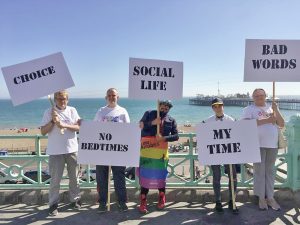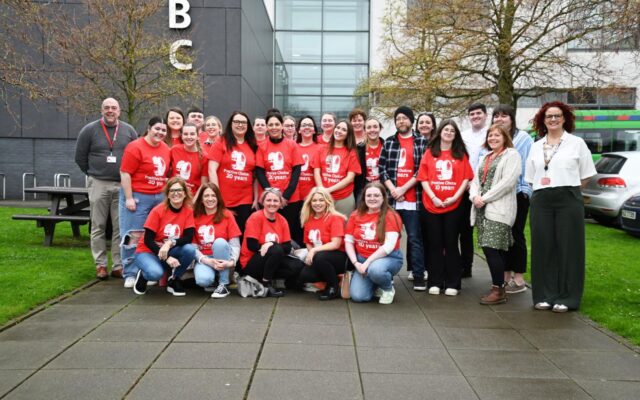After fighting to get her autistic son released from a locked ward, Julie Newcombe could not walk away knowing other parents were in the same boat. She talks about why an approach based on human rights is needed, and an exhibition, Rightful Lives, which explores this.
Sometimes, it would be nice to go back to the old days. The days when you still thought, naively, that you would get proper help for your disabled child. The days when you just assumed a big parcel of practical assistance and emotional support would land on your doorstep and everything would be OK. The days when you weren’t beaten and exhausted.
It certainly was not like that when our son, Jamie, was diagnosed with autism. Over the years, he has gained a few more medical terms after his name, but this has not made a lot of difference to that parcel of help. We have had to fight for pretty much everything along the way. Education, benefits, the right care and therapy – it has been one continuing struggle.
Certainly, there have been some good people, such as individual teachers, care workers and professionals, who have gone above and beyond the call of duty to make a difference but, sadly, the system is set up to make an adversarial approach the norm.
Our biggest battle came when Jamie was detained under the Mental Health Act at the age of 18. Changes in medication and a distinctly punitive approach to behaviour management by his care team at the time resulted in him being admitted to a psychiatric unit.
Five hospitals, a broken arm and some questionable medication changes later, he was discharged to a lovely home where he has since thrived. While he was locked up, he was regularly restrained, put in seclusion and overmedicated. Yet I visited him and took him out into the community almost every day by myself without any issues at all. Our experiences within the mental health system were so damaging that I could not walk away once Jamie was free, especially after it became obvious that so many other families out there have had or are still having similar experiences.
 It became important to campaign for change and to support others going through the same thing. I have been involved in various projects and campaigns, but by far the most inspiring and far-reaching has been the Rightful Lives online exhibition, which I co-founded with Mark Brown, a researcher and web designer, and counsellor, author and parent advocate Mark Neary.
It became important to campaign for change and to support others going through the same thing. I have been involved in various projects and campaigns, but by far the most inspiring and far-reaching has been the Rightful Lives online exhibition, which I co-founded with Mark Brown, a researcher and web designer, and counsellor, author and parent advocate Mark Neary.
Rightful Lives aims to explore the human rights of autistic people and those with learning disabilities. The exhibition is set up in a series of online rooms. Some of the rooms hold exhibits relating to specific articles in the Human Rights Act. For example, we look at the ‘right to life’ or the ‘right to freedom from inhuman and degrading treatment’. Other rooms look at ‘living life’ and at people’s perspectives. Our last update introduced the theme of ‘a day in the life’, where people could send us the story of their day. 
In an astonishing array of love, joy, anger and grief, the exhibitors show how it is possible to lead a truly meaningful life when things go right and, equally, how utterly appalling it can be when people do not get the right help and their human rights are ignored. Curating it was an amazing, wonderful experience as we received exhibit after exhibit which took our breath away. The dignity of individuals who have suffered the greatest losses is heart-wrenching, while the joy of those leading great lives and doing great things is infectious. We firmly believe the only way to secure meaningful, lasting change for autistic people and those with learning disabilities is to use a rights-based approach that holds authorities to account when they break the law.Sadly, authorities disregard the law far too often and with apparent impunity.
Individuals and their families and supporters need to be included in decisions about their day-to-day life. They should be leading the process, not playing catch-up with whatever the professionals decide should happen next. We are working to establish a rights-based approach and this objective is certainly gaining momentum. In the meantime, visit the Rightful Lives exhibition (see link at end). You won’t be disappointed.
Human rights and home truths
As we move forward with establishing a rightful life for Jamie, we are looking at the possibility of finding him somewhere to live closer to us. This is something he wants and he makes that very clear.
The residential home where he lives now is at least an hour away. It is a lovely place with an amazing care team, but he would rather be closer to us. That fits with his article 8 rights, under the European Convention on Human Rights, to respect for a private and family life.
As a result, I have started looking at supported living … and that is a phenomenon in its own right. The thinking behind it is summarised in article 19 of the Convention on the Rights of Persons with Disabilities (United Nations, 2008):
a) Persons with disabilities have the opportunity to choose their place of residence and where and with whom they live on an equal basis with others and are not obliged to live in a particular living arrangement;
b) Persons with disabilities have access to a range of in-home, residential and other community support services, including personal assistance necessary to support living and inclusion in the community, and to prevent isolation or segregation from the community;
c) Community services and facilities for the general population are available on an equal basis to persons with disabilities and are responsive to their needs.
The idea is that a person should live in their own home, alongside people with whom they choose to live and be able to live inclusive community lives.
The Reach support for living standards, drawn up up by Paradigm, takes this further and stipulates that people should have the right to choose all of the following: who they live with; where they live; how they are supported; who supports them; friends and relationships; how to be healthy and safe; how they choose to be part of the community.
All of this should take place in their own homes, where they get good support, help to make changes in their lives, and have the same rights and responsibilities as other citizens (Paradigm, 2014). These principles are reflected in the National Development Team for Inclusion’s ‘real tenancy test’, which stipulates the requirements for a tenancy to be genuine, with a tenancy agreement in place, tenants having control over where they live and who with, their support and how they are supported, and what happens in their own home (NDTI, 2015).
Sadly, the reality for many people in supported living is different. Inevitably, it is all about money. People with a tenancy can claim housing benefit or universal credit to cover the cost of the rent and use their own money or other welfare benefits to cover outgoings. The only costs a local authority normally has to bear are care costs. However, rather than set up homes for individuals with bespoke care teams, the trend has been for private providers to establish shared housing with pooled budgets and pooled care teams. The notion of choosing who you live with or who supports you has gone out of the window and the ‘tenant’ is left in what is a residential home in all but name.
At the same time, local authorities are not addressing the housing issue. Homes to meet the needs of all should be developed. The situation is worsened by the fact that the Care Quality Commission tends not to visit supported living settings because its inspectors cannot enter a person’s home without permission. They inspect the care providers at their offices instead. As a result, the protection an inspection should provide may be diluted or nonexistent and the reality of people’s situations is not seen.
The CQC does not seem to have got to grips with its responsibility to ensure that spurious supported living schemes are run correctly and should be registered. Its own Housing with Care standards say landlord and care provider should be clearly separate and that tenants should be able to choose who enters their home to offer care. However, local commissioners continue to use a model that does not ensure these rights, presumably because it is cheaper. A general lack of accountability means public employees continue to get away with it. The CQC really needs to do more to uphold people’s rights.
I do not doubt there are cases where this pseudo-model works well and that some people might choose it. I recognise and applaud that there should be choice within the system for different models of care and housing.
However, where there are guidelines and rules, these should be followed. Rights are paramount. We all need a place of our own – a sanctuary – and we need to make good housing and support a reality and not strip out the very essence of community life.
In the meantime, no doubt, our battles will continue, but we will continue to strive to ensure Jamie’s human rights are upheld. I will carry on banging the rights-based drum to fight for change. Those with the power to make change have many questions to answer. Let’s get those answers.
The Rightful Lives online exhibition can be visited at www.rightfullives.net
Julie Newcombe is the mum of a wonderful young man with autism and learning disabilities and a co-founder of the Rightful Lives exhibition
References
United Nations (2008) Convention on the Rights of People with Disabilities. Article 19 Ð Living Independently and Being Included in the Community. http://tinyurl.com/zajxuth
Paradigm (2014) The REACH Support for Living Standards. http://tinyurl.com/yyf9wuku
National Development Team for Inclusion (2015) The Real Tenancy Test – Tenancy Rights In Supported Accommodation. Revised November 2015. http://tinyurl.com/y4z8uutz





